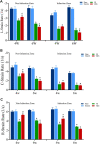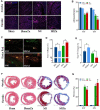Long-Term Inhalation of Ultrafine Zinc Particles Deteriorated Cardiac and Cardiovascular Functions in Rats of Myocardial Infarction
- PMID: 35910581
- PMCID: PMC9325963
- DOI: 10.3389/fphys.2022.921764
Long-Term Inhalation of Ultrafine Zinc Particles Deteriorated Cardiac and Cardiovascular Functions in Rats of Myocardial Infarction
Abstract
Substantial ultrafine zinc particles exist in air pollutions. The level of Zn concentrations in serum and tissue could affect patients with myocardial infarction (MI). The aim of the study is to investigate the change of cardiac functions and peripheral hemodynamics in MI rats after long-term inhalation of ultrafine Zn particles. Coronary artery ligation surgery was performed to induce MI in Wistar rats. The inhalation of ultrafine Zn particles was carried out for 6 weeks after the operation. Physiological and hemodynamic measurements and computational biomechanics analysis were demonstrated in eight groups of rats at postoperative 4 and 6 weeks. There was no statistical significance between shams and shams with inhalation of ultrafine Zn particles. There were significant impairments of cardiac and hemodynamic functions in MI rats. In comparison with MI rats, the inhalation of ultrafine Zn particles for 4 weeks slowed down the progression from MI to heart failure, but the inhalation for 6 weeks accelerated the process. The long-term inhalation of ultrafine zinc particles induced excessive accumulation of zinc in serum and tissue, which deteriorated cardiac and hemodynamic dysfunctions in MI rats. The findings suggested the importance for regulating Zn intake of MI patients as well as looking at ways to lower zinc concentrations in air pollutions.
Keywords: Womersley analysis; myocardium infraction; speckle-tracing echocardiography; strain analysis; ultrafine zinc particle.
Copyright © 2022 Huo and Li.
Conflict of interest statement
The authors declare that the research was conducted in the absence of any commercial or financial relationships that could be construed as a potential conflict of interest.
Figures




Similar articles
-
Long-term inhaling ultrafine zinc particles increases cardiac wall stresses elevated by myocardial infarction.Biomed Eng Online. 2024 Aug 5;23(1):78. doi: 10.1186/s12938-024-01275-3. Biomed Eng Online. 2024. PMID: 39103913 Free PMC article.
-
Short-Term Inhalation of Ultrafine Zinc Particles Could Alleviate Cardiac Dysfunctions in Rats of Myocardial Infarction.Front Bioeng Biotechnol. 2021 Apr 14;9:646533. doi: 10.3389/fbioe.2021.646533. eCollection 2021. Front Bioeng Biotechnol. 2021. PMID: 33937215 Free PMC article.
-
Inhalation of Ultrafine Zinc Particles Impaired Cardiovascular Functions in Hypertension-Induced Heart Failure Rats With Preserved Ejection Fraction.Front Bioeng Biotechnol. 2020 Jan 24;8:13. doi: 10.3389/fbioe.2020.00013. eCollection 2020. Front Bioeng Biotechnol. 2020. PMID: 32039193 Free PMC article.
-
Significance of particle parameters in the evaluation of exposure-dose-response relationships of inhaled particles.Inhal Toxicol. 1996;8 Suppl:73-89. Inhal Toxicol. 1996. PMID: 11542496 Review.
-
Ultrafine particle-lung interactions: does size matter?J Aerosol Med. 2006 Spring;19(1):74-83. doi: 10.1089/jam.2006.19.74. J Aerosol Med. 2006. PMID: 16551218 Review.
Cited by
-
Myocardial infarction impaired wall mechanics and hemodynamics in peripheral arteries.Front Physiol. 2023 Aug 29;14:1266568. doi: 10.3389/fphys.2023.1266568. eCollection 2023. Front Physiol. 2023. PMID: 37705604 Free PMC article.
-
Long-term inhaling ultrafine zinc particles increases cardiac wall stresses elevated by myocardial infarction.Biomed Eng Online. 2024 Aug 5;23(1):78. doi: 10.1186/s12938-024-01275-3. Biomed Eng Online. 2024. PMID: 39103913 Free PMC article.
References
-
- Brenner W., Aicher A., Eckey T., Massoudi S., Zuhayra M., Koehl U., et al. (2004). 111In-labeled CD34+ Hematopoietic Progenitor Cells in a Rat Myocardial Infarction Model. J. Nucl. Med. 45 (3), 512–518. - PubMed
-
- Chatzikyriakou S. V., Tziakas D. N., Chalikias G. K., Stakos D. A., Thomaidi A. K., Mitrousi K., et al. (2014). Serum Levels of Collagen Type-I Degradation Markers Are Associated with Vascular Stiffness in Chronic Heart Failure Patients. Eur. J. Heart Fail 10 (12), 1181–1185. 10.1016/j.ejheart.2008.09.007 - DOI - PubMed
LinkOut - more resources
Full Text Sources

